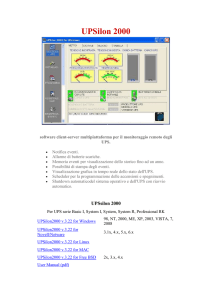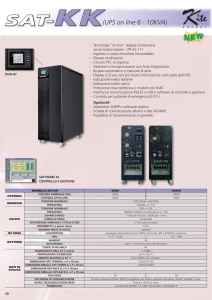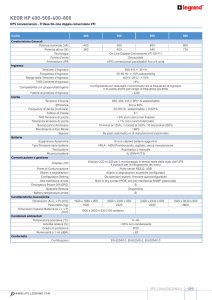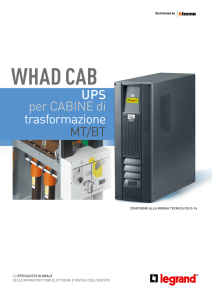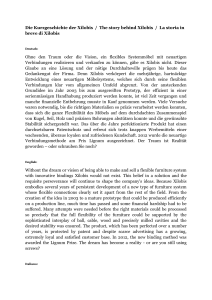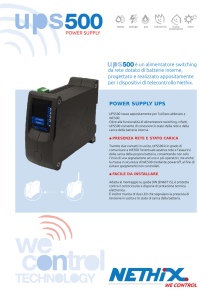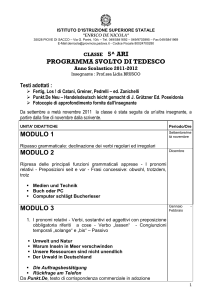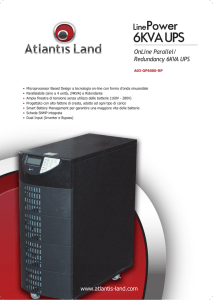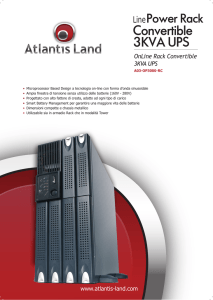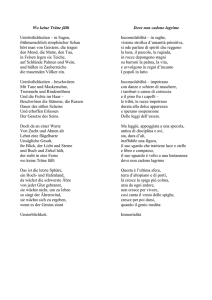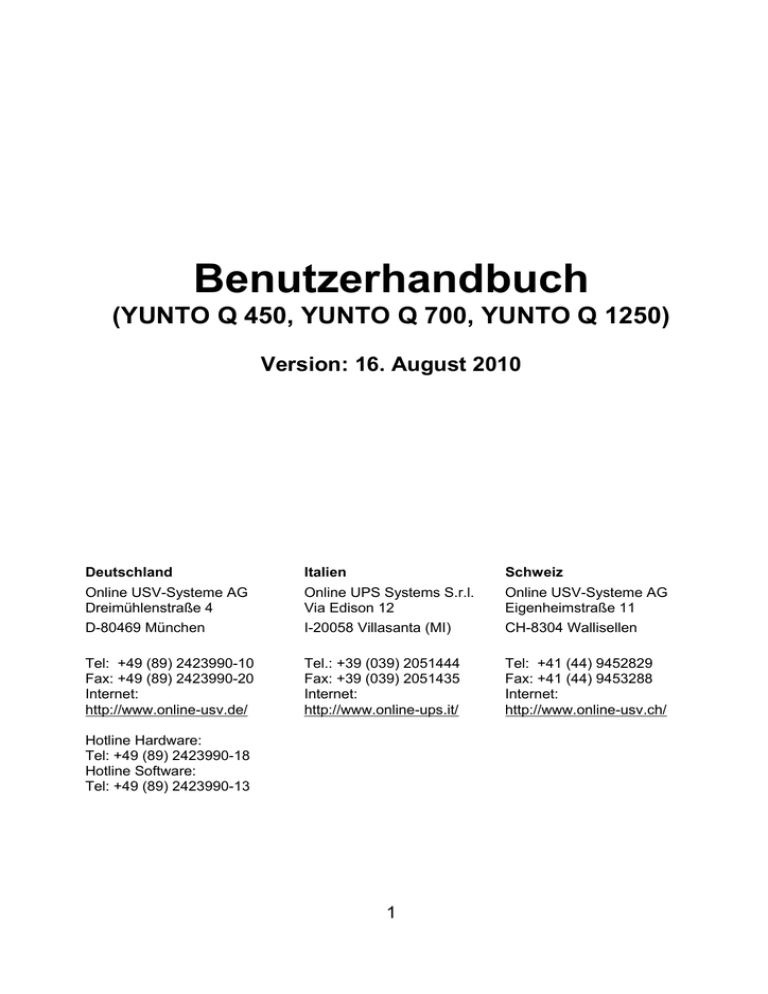
Benutzerhandbuch
(YUNTO Q 450, YUNTO Q 700, YUNTO Q 1250)
Version: 16. August 2010
Deutschland
Italien
Schweiz
Online USV-Systeme AG
Dreimühlenstraße 4
Online UPS Systems S.r.l.
Via Edison 12
Online USV-Systeme AG
Eigenheimstraße 11
D-80469 München
I-20058 Villasanta (MI)
CH-8304 Wallisellen
Tel: +49 (89) 2423990-10
Fax: +49 (89) 2423990-20
Internet:
http://www.online-usv.de/
Tel.: +39 (039) 2051444
Fax: +39 (039) 2051435
Internet:
http://www.online-ups.it/
Tel: +41 (44) 9452829
Fax: +41 (44) 9453288
Internet:
http://www.online-usv.ch/
Hotline Hardware:
Tel: +49 (89) 2423990-18
Hotline Software:
Tel: +49 (89) 2423990-13
1
Inhalt
1.
Einleitung ............................................................................................... 3
2.
Sicherheitshinweise.............................................................................. 3
3.
Anzeige- und Bedienelemente ............................................................. 6
4.
Installieren und einschalten ................................................................. 7
5.
Fehler beheben ...................................................................................... 9
6.
6.1
6.2
6.3
6.4
6.5
7.
Technische Daten................................................................................ 11
Elektrische Spezifikation....................................................................... 11
Typische Überbrückungszeit (Batteriebetrieb) ..................................... 12
Maße und Gewichte…………......………………………....…………….. 12
Betriebsumgebung................................................................................ 12
Schnittstellenanschluß.......................................................................... 12
Anhang ................................................................................................. 13
Abbildungsverzeichnis
Abbildung 1: Anschließen der USV ................................................................ 8
Abbildung 2: Vorder- und Rückansicht YUNTO Q 450 ................................ 13
Abbildung 3: Vorder- und Rückansicht YUNTO Q 700 ................................ 14
Abbildung 4: Vorder- und Rückansicht YUNTO Q 1250 .............................. 15
2
1. Einleitung
Die Online USV YUNTO Q-Serie ist eine neuentwickelte Line-InteractiveUSV (Unterbrechungsfreie Stromversorgung). Sie schützt PCs optimal vor
Stromausfällen, Spannungseinbrüchen, Unter- und Überspannungen,
Spannungsspitzen und Transienten.
2. Sicherheitshinweise
VOR INSTALLATION UND INBETRIEBNAHME DAS
BENUTZERHANDBUCH UND DIE SICHERHEITSHINWEISE
AUFMERKSAM LESEN UND BEACHTEN!
Transport
• USV nur in der Originalverpackung transportieren (Schutz gegen Stoß
und Schlag).
Aufstellung
• Die USV ist für den Betrieb in geschlossenen Räumen konzipiert.
• Wird die USV aus kalter Umgebung in den Arbeitsraum gebracht, kann
Betauung auftreten. Vor Inbetriebnahme muß die USV absolut trocken
sein. Deshalb eine Aklimatisationszeit von mindestens zwei Stunden
abwarten.
• USV nicht in der Nähe von Wasser oder in feuchter Umgebung
aufstellen.
• USV nicht in direktem Sonnenlicht oder in der Nähe von Wärmequellen
aufstellen.
3
Anschluß
• USV nur an eine geerdete Schutzkontaktsteckdose anschließen.
• Steckdose der Hausinstallation (Schutzkontaktsteckdose) muß leicht
zugänglich sein und sich in der Nähe der USV-Anlage befinden.
• Zum Anschluß der USV an die Steckdose der Hausinstallation
(Schutzkontaktsteckdose)
nur
ein
VDE-geprüftes
und
CEgekennzeichnetes Stromkabel (z.B. das Ihres Computers) verwenden.
• Zum Anschluß der Verbraucher an die USV nur VDE-geprüfte und CEgekennzeichnete Stromkabel verwenden.
• Keine Haushaltsgeräte, wie beispielsweise Haartrockner, an USVAusgangssteckdosen anschließen.
• Keine Geräte an die USV-Ausgangssteckdosen anschließen, die die
USV überlasten (z. B. Laserdrucker).
• Leitungen so verlegen, daß niemand darauf treten oder darüber
stolpern kann.
• Installierbar durch den Betreiber.
• Bedienung durch jedermann ohne Vorkenntnisse.
• Bei der Installation dieses Gerätes ist darauf zu achten, daß die
Summe der Ableitstöme der USV und der angeschlossenen
Verbraucher den Maximalwert von 3.5mA nicht überschreiten.
Betrieb
• Stromkabel während des Betriebs nicht von der USV oder der
Steckdose der Hausinstallation (Schutzkontaktsteckdose) abziehen, da
sonst die Schutzerdung der USV und aller angeschlossenen
Verbraucher aufgehoben wird.
• Die USV verfügt über eine eigene, interne Stromquelle (Batterien). Die
USV-Ausgangssteckdosen können stromführend sein, selbst wenn die
USV nicht an die Steckdose der Hausinstallation angeschlossen ist.
• Zum völligen Abschalten der USV zunächst den Schalter
drücken und dann das Stromkabel herausziehen.
„Ein/Aus“
• Darauf achten, daß keine Flüssigkeit oder sonstige Fremdkörper in die
USV gelangen.
4
Wartung, Service, Störungen
• Die USV enthält Spannungen, die gefährlich sind. Reparaturen sind
grundsätzlich nur von qualifiziertem Wartungspersonal durchzuführen.
• Achtung - Gefahr von Stromschlägen. Selbst nach Trennung vom
Stromversorgungsnetz bleiben Bauteile innerhalb der USV an der
Batterie angeschlossen und befinden sich unter gefährlichem
Spannungspotential. Vor der Durchführung von Service- und
Wartungsarbeiten
Batterieversorgungskreis
trennen
und
Spannungsfreiheit prüfen.
• Das Auswechseln der Batterien ist von Personal mit Sachkenntnis über
Batterien und Kenntnis über die geforderten Vorsichtsregeln
durchzuführen und zu überwachen. Unbefugte Personen sind von den
Batterien fernzuhalten.
• Achtung – Gefahr von Stromschlägen. Der Batteriekreis ist nicht von
der Eingangsspannung isoliert. Zwischen den Batterieanschlüssen und
der Erde können gefährliche Spannungen auftreten. Überprüfen Sie vor
Beginn der Arbeiten die Spannungsfreiheit.
• Batterien können Stromschlag verursachen und weisen hohen
Kurzschlußstrom auf. Bei Arbeiten mit Batterien sind u. a. folgende
Vorsichtsmaßregeln zu beachten:
- Armbanduhren, Ringe oder andere Metallgegenstände entfernen.
- nur Werkzeuge mit isolierten Griffen verwenden.
• Beim Austauschen der Batterien dieselbe Anzahl und denselben
Batterietyp verwenden.
• Batterien nicht ins Feuer werfen, die Batterien könnten explodieren.
• Batterien nicht öffnen oder zerstören. Freigesetztes Elektrolyt ist
schädlich für Haut und Augen. Es kann giftig sein.
• Zum Schutz vor einem Brand darf die Sicherung nur durch einen
gleichen Typ mit gleichem Nennwert ersetzt werden.
• Verbrauchte Batterien umweltgerecht entsorgen.
• USV nicht auseinanderbauen.
5
3. Anzeige- und Bedienelemente
Die LEDs an der Gerätevorderseite zeigen zusammen mit dem akustischen
Signal (Pfeifton) den Betriebszustand der USV an.
Schalter und
LED
Ein/Aus
Symbol
Funktion
USV ein- und ausschalten.
1. leuchtet: Eingangsspannung in
Ordnung, USV
arbeitet im Normalbetrieb.
Status-LED
(grün)
2. blinkt: Eingangsspannung außerhalb
der zulässigen Toleranzen, Versorgung
der Verbraucher aus der Batterie der
USV (Batteriebetrieb).
3. aus: Keine Spannung am USV-Eingang
oder
Batterie entladen oder
USV ausgeschaltet.
Fehler-LED
(rot)
1. blinkt: Die USV ist überlastet oder ein
Test der Batterie ist fehlgeschlagen.
2. leuchtet: USV-Fehler.
Akustisches
Signal
Funktion
Pfeifton für 2
Sekunden
USV wird gestartet.
1 Ton alle 4 sec
Stromausfall: Versorgung der Verbraucher aus der
Batterie der USV (Batteriebetrieb).
1 Ton jede sec
Batteriekapazität gering: USV arbeitet im
Batteriebetrieb, die Batterien sind nahezu entladen,
die USV wird sich in kürze abschalten.
6
1 Ton alle 2 sec
Batterie nicht vollständig geladen: USV arbeitet im
Normalbetrieb, die Batterie ist nicht vollständig
geladen; sollte ein Stromausfall eintreten, ist die
Überbrückungszeit geringer als der Nennwert.
3 Töne alle 2 sec
Batteriewechsel notwendig.
2 Töne alle 2 sec
Batterieladung nicht möglich: USV kann die Batterie
nicht aufladen. Bitte sehen Sie im Kapitel Fehler
beheben nach, wie Sie die Störung beseitigen
können.
1 Ton jede
halbe sec
Überlast. Bitte sehen Sie im Kapitel Fehler beheben
nach, wie Sie die Störung beseitigen können.
Permanenter Ton
Fehler: bitte kontaktieren Sie Ihren Händler.
4. Installieren und einschalten
1) Überprüfen Sie den Verpackungskarton und den Inhalt auf Schäden.
Sollten Sie Schäden feststellen, informieren Sie sofort den Spediteur.
Bewahren Sie die Verpackung für künftige Verwendungszwecke auf.
2) Schließen Sie die USV an eine Schutzkontaktsteckdose an (siehe
Abbildung 1). Die USV startet nach Betätigung des
-Tasters an der
Frontseite der USV. Während des Startvorgangs ertönt ein Piepston und
beide LEDs an der Front der USV leuchten für 2 Sekunden.
Anschließend leuchtet die grüne LED kontinuierlich. Dies zeigt die
einwandfreie Funktion der USV an.
3) Betreiben Sie die USV für mindestens 2 Stunden ohne angeschlossene
Verbraucher am Netz, um die Batterien zu laden. Sie können die USV
bereits nutzen, wenn die Batterien noch geladen werden, allerdings ist
die Überbrückungszeit bei Stromausfall geringer als der Nennwert. Es
dauert maximal 8 Stunden bis die Batterien vollständig geladen sind.
Hinweis:
Wenn die USV weiterhin pfeift oder die grüne LED nicht leuchtet,
obwohl die USV an die Schutzkontaktsteckdose der Hausinstallation
angeschlossen ist, sehen Sie bitte im Kapitel Fehler beheben nach,
wie die Störung beseitigt werden kann.
7
4) Schalten Sie die Verbraucher ab, die die USV absichern soll. Schließen
Sie diese Verbraucher an die USV-Ausgangssteckdosen an.
5) Schalten Sie die abzusichernden Verbraucher nacheinander ein.
AC INTPUT
230V~ 50/60Hz
Charger
AC OUTPUT
230~ 50/60Hz
Relay
Inverter
DC Converter
CNTL 70X3
Interface
MAIN BLOCK DIAGRAM
Abbildung 1: Anschließen der USV
8
5. Fehler beheben
Wenn die USV nicht einwandfrei arbeitet, versuchen Sie bitte anhand
folgender Tabelle das Problem zu lösen.
Problem
Keine Anzeige,
kein Pfeifton, obwohl die USV an
die Schutzkontaktsteckdose der
Hausinstallation
angeschlossen ist.
Mögliche
Ursache
Abhilfe
Keine Spannung
am USV-Eingang
Die Sicherung
der USV ist
durchgebrannt
Ausfall der
Stromversorgung
Grüne LED blinkt,
rote LED aus,
1 Ton alle 4 sec
Grüne LED blinkt,
rote LED aus,
1 Ton jede sec
USV Eingangsstromkabel nicht
angeschlossen
Eingangsstromkabel schadhaft
Batterie nahezu
entladen
9
Überprüfen Sie die Steckdose
der Hausinstallation und das
USV-Eingangsstromkabel,
indem Sie einen anderen Verbraucher mit diesem Stromkabel an dieser Steckdose
betreiben.
Ersetzen Sie die Sicherung der
USV durch eine gleichen Typs
und gleichem Nennwert.
Nicht notwendig, Verbraucher
werden von der USV mit Strom
versorgt.
Stellen Sie sicher, daß das
Eingangsstromkabel der USV
korrekt angeschlossen ist.
Bitte wenden Sie sich an Ihren
Händler.
Laden Sie die USV wie im Kap.
Installieren und einschalten
beschrieben auf. Sollte die Fehlermeldung anschließend immer
noch erscheinen, wird die USV
während eines Stromausfalls
nicht arbeiten oder sich nach
kurzer Zeit abschalten. Wenden
Sie sich bitte an Ihren Händler.
Grüne LED
leuchtet, rote LED
blinkt, 2 Töne alle
2 sec.
Grüne LED
leuchtet, rote LED
blinkt, 1 Ton jede
halbe sec.
Grüne LED aus,
rote LED leuchtet,
permanenter Ton.
Batterie kann
nicht geladen
werden, Ladeteil
defekt
Es sind zu viele
Verbraucher an
der USV angeschlossen
Kurzschluß am
USV-Ausgang
Belastung des
USV-Ausgangs
größer als 120%
USV Fehler
Bitte wenden Sie sich an Ihren
Händler.
Reduzieren Sie die Anzahl der
Verbraucher am USV-Ausgang,
bis die USV nicht mehr pfeift.
Entfernen Sie alle Verbraucher
vom USV-Ausgang und kontaktieren Sie Ihren Händler.
Reduzieren Sie die Anzahl der
Verbraucher am USV-Ausgang,
bis die USV nicht mehr pfeift.
Kontaktieren Sie Ihren Händler.
Bei Benachrichtigung der Serviceabteilung halten Sie bitte folgende
Informationen bereit:
1. Modellnummer, Seriennummer
2. Datum, an dem das Problem auftrat
3. Ausführliche Beschreibung des Problems
10
6. Technische Daten
6.1 Elektrische Spezifikation
Modell
EINGANG
Spannung
Frequenz
Maximaler
Strom
Phase
YUNTO Q 450
YUNTO Q 700
2.6 A
230 VAC (197 - 262 VAC)
50 Hz ± 4Hz ; 60Hz±4Hz
4.0 A
7.0 A
1ψ 2W, Ground
AUSGANG
Leistung
Spannung
Frequenz
Wellenform
Aufladezeit
Overload
protection
YUNTO Q1250
450 VA
270 W
700 VA
420 W
230 VAC ± 10 %
50 Hz ± 1Hz ; 60 Hz ± 1Hz
STEP
8hr up to 90%
1250 VA
750 W
Line mode ≧ 105%, ≦ 130% load 3 minutes to fault
Line mode > 130%
7s to fault
Battery mode ≧ 105% ≦ 120% 20s to shutdown
load
Battery mode > 120% load
5s to shutdown
Die Geräte haben CE-Kennzeichen und erfüllen folgende Normen:
EN 62040-1-1: 2003
IEC 60950-1: 2001
EN 50091-2: 1995
EN 62040-2: 1999
EN 61000-2-2: 1990
IEC 61000-4-2: 2001
IEC 61000-4-3: 2001
IEC 61000-4-4: 2001
IEC 61000-4-5: 2001
11
6.2
Typische Überbrückungszeit (Batteriebetrieb)
Typische Werte bei 25°C in Minuten:
Modell
100 % Last
YUNTO Q 450
3
YUNTO Q 700
2.5
YUNTO Q1250
3
6.3
Maße und Gewichte
Modell
YUNTO Q 450
YUNTO Q 700
YUNTO Q1250
6.4
50 % Last
6
6
6
Dimensions
W x H x D (mm)
80*180*235
80*180*235
95*240*285
Net Weight,
kg
3.5
3.6
6.5
Gross Weight, kg
4.5
4.6
7.9
Betriebsumgebung
Temperatur bei Betrieb: 0 °C bis 40 °C
Temperatur bei Lagerung: -15 °C bis 40 °C
Relative Feuchte bei Betrieb:
20% bis 90%
6.5
Schnittstellenanschluß
Über die Schnittstellenanschlüsse RS-232 und USB an der Rückseite der
USV kann ein Computer angeschlossen werden. Dieser Anschluß
ermöglicht
• die Überwachung der USV,
• die Überwachung des Stromversorgungsnetzes,
• die Sicherung von Daten,
• die Abschaltung des Computers und
• die Abschaltung der USV.
Die RS232-Schnittstelle wird an einer 9-poligen Sub-D-Buchse zur
Verfügung gestellt.
Beschreibung der PIN-Belegung:
Pin
Symbol
Means
2
RXD
Received data
3
TXD
transmitted data
5
GND
Ground
12
7. Anhang
Abbildung 2: Vorder- und Rückansicht YUNTO Q 450
13
Abbildung 3: Vorder- und Rückansicht YUNTO Q 700
14
Abbildung 4: Vorder- und Rückansicht YUNTO Q 1250
15
User Manual
(YUNTO Q450, YUNTO Q700, YUNTO Q1250)
Germany
Italy
Switzerland
Online USV-Systeme AG
Dreimühlenstraße 4
Online UPS Systems S.r.l.
Via Edison 12
Online USV-Systeme AG
Industriestraße 26
D-80469 München
I-20058 Villasanta (MI)
CH-8604 Volketswil
Tel: +49 (89) 2423990-10
Fax: +49 (89) 2423990-20
TEL:+39 (039) 2051444
Fax: +39 (039) 2051435
Tel: +41 (44) 9452829
Fax:+41 (44) 9453288
Internet:
http://www.online-usv.de/
Internet:
http://www.online-ups.it/
Internet:
http://www.online-usv.ch/
Hotline hardware:
Tel: +49 (89) 2423990-18
Hotline software:
Tel:+49 (89) 2423990-13
16
Contents
1.
Introduction.......................................................................................... 18
2.
Safety Instructions .............................................................................. 18
3.
Indicators and Operating Controls .................................................... 22
4.
Installation and Start Up ..................................................................... 23
5.
Troubleshooting .................................................................................. 24
6.
Technical data...................................................................................... 26
6.1
Electrical specifications .................................................................. 26
6.2
Typical stored energy time (Battery mode) .................................... 27
6.3
Dimensions and weights ................................................................ 27
6.4
Operating environment................................................................... 27
6.5
Port connectors .............................................................................. 27
7.
Appendix .............................................................................................. 28
List of Figures
Figure 1: Connection of the UPS ……………………………………………….23
Figure 2: Front and back view of YUNTO Q450 ……………………………...28
Figure 3: Front and back view of YUNTO Q700 ………………………...……29
Figure 4: Front and back view of YUNTO Q1250 …………………………….30
17
1. Introduction
The ONLINE YUNTO Q-Series is a newly developed line interactive UPS
(uninterruptible power supply). It provides perfect protection for personal
computers against power failures. It also provides spike suppression and line
noise filtering to protect critical equipment.
2. Safety Instructions
PLEASE READ THROUGH AND FOLLOW THE USER MANUAL AND
THE SAFETY INSTRUCTIONS BEFORE INSTALLING THE UNIT AND
STARTING IT UP!
Transport
• Please transport the UPS system only in the original packaging (to
protect against shock and impact).
Set-up
• The UPS is designed for indoor operation.
•
Condensation may occur if the UPS system is moved directly from a
cold to a warm environment. The UPS system must be absolutely dry
before being installed. Please allow an acclimatisation time of at
least two hours.
• Do not install the UPS system near water or in damp environments.
•
Do not install the UPS system where it would be exposed to direct
sunlight or near heat.
18
Installation
• Connect the UPS system only to socket outlet with earthing contact
(Schuko-socket outlet).
• The building wiring socket outlet (Schuko-socket outlet) must be easily
accessible and close to the UPS system.
• Use only VDE-approved, CE-marked power cable (e.g. the power cable of
your computer) to connect the UPS system to the building wiring socket
outlet (Schuko-socket outlet).
• Use only VDE-approved, CE-marked power cables to connect the loads
to the UPS system.
• Do not connect domestic appliances such as hair dryers to UPS output
sockets.
• Do not connect appliances or items of equipment, which would overload
the UPS system (e.g. laser printers), to the UPS outlet socket.
• Place cables in such a way that no one can step on or trip over them.
• This is operator installable.
• The UPS can be operated by any individuals with no previous experience.
• With the installation of the equipment it should prevented, that the sum of
the leakage current of the UPS and the connected consumer does not
exceed 3.5mA.
Operation
• Do not disconnect the mains cable on the UPS system or the building
wiring socket outlet (Schuko-socket outlet) during operation since this
would cancel the protective earthing of the UPS system and of all
connected loads.
• The UPS system features its own, internal current source (batteries).
The UPS output sockets may be electrically live even if the UPS system is
not connected to the building wiring socket outlet.
• In order to fully disconnect the UPS system, first press the
then disconnect the mains lead.
switch
• Ensure that no fluids or other foreign objects can enter the UPS system.
19
Maintenance, servicing and faults
• The UPS system operates with hazardous voltages. Only qualified
maintenance personnel may carry out repairs.
•
Caution - risk of electric shock. Even after the unit is disconnected
from the mains power supply (building wiring socket outlet), components
inside the UPS system are still connected to the battery and are still
electrically live and dangerous. Before carrying out any kind of servicing
and/or maintenance, disconnect the batteries and verify that no current
is present.
• Only persons adequately familiar with batteries and with the required
precautionary measures may exchange batteries and supervise
operations. Unauthorised persons must be kept well away from the
batteries.
• Caution - risk of electric shock. The battery circuit is not isolated from
the input voltage. Hazardous voltages may occur between the battery
terminals and the ground. Before touching, verify that no voltage is
present!
• Batteries may cause electric shock and have a high short-circuit current.
Please take the precautionary measures specified below and any other
measures necessary when working with batteries:
- remove wristwatches, rings and other metal objects.
- use only tools with insulated grips and handles.
• When replacing the batteries, use same number and same type of
batteries.
• Do not attempt to dispose of batteries by burning them. This could
cause battery explosion.
• Do not open or destroy batteries. Escaping electrolyte can cause injury
to the skin and eyes. It may be toxic.
• Please replace the fuse only by a fuse of the same type and of the same
amperage in order to avoid fire hazards.
• Do not dismantle the UPS system.
• Exhausted batteries should be given to a recycling company.
20
3. Indicators and Operating Controls
The front panel LEDs and audio beeps indicate the UPS status.
Switch and LEDs
Symbol
Function
On/Off
Turn the UPS system on and off.
Status-LED
(green)
1. Steady: Input power is acceptable,
the UPS is in normal mode (online).
2. Blinking: Input power is out of
tolerance, the UPS is in battery mode.
3. Off: No input power or
the battery is exhausted or
the UPS is switched off.
Fault-LED
(red)
1. Blinking: The UPS is overloaded or
has failed at battery test.
2. Steady: UPS fault.
Beeps
Function
Beep continuously
for 2 sec
Starting up the UPS.
1 beep every 4 sec
Power failure: UPS is in battery mode.
1 beep every sec
Battery low: UPS is in battery mode, batteries are
nearly exhausted, UPS will be shut down.
1 beep every 2 sec
Battery weak: UPS in normal mode (online), battery is
not fully charged, backup time during power failure
shorter than nominal value.
3 beeps every 2
sec
Battery replacement: battery needs to be replaced.
2 beeps every 2
sec
Charger fault: UPS can not recharge the battery. See
chapter Troubleshooting for more information.
1 beeps every half
sec
Overload. See chapter Troubleshooting for more
information.
Continuous
Fault: please contact your dealer.
21
4. Installation and Start Up
1) Inspect the packaging carton and its contents for damage. Please inform
the transport agency immediately should you find signs of damage.
Please keep the packaging in a safe place for future use.
2) Plug the UPS into a wall outlet (see figure 1), and press the
on the
front panel, then the UPS come into work. When the UPS starts, it will
beep and both LEDs of the front panel will light up for 2 seconds. The
green light should light up continuously. This indicates normal operation.
3) Let the UPS charge the battery for at least 2 hours. You may use the UPS
while the battery charges, but the UPS backup time will be reduced until
the battery is fully charged. It will take up to 8 hours to charge the fully
discharged battery.
Note:
If the UPS continues to beeps, or the green light is not alight even mains
power is available, please see the chapter Troubleshooting for more
information.
3) Switch off the equipment you want to protect, and connect it to the outlets
of the UPS.
4) Switch on the protected equipment, one piece per time.
22
AC INTPUT
230V~ 50/60Hz
Charger
AC OUTPUT
230~ 50/60Hz
Relay
Inverter
DC Converter
CNTL 70X3
Interface
MAIN BLOCK DIAGRAM
Figure 1: Connection of the UPS
23
5. Troubleshooting
If the UPS system does not operate correctly, please attempt to solve the
problem using the table below.
Problem
Possible cause
Remedy
No indication, no No input voltage
Check building wall outlet and
beep even UPS is
mains cable by connecting
connected to mains
another device with this cable
power supply
to this wall outlet
Fuse has been melt
Replace fuse by fuse with
same rating
Green LED blinks,
Mains power failure
Wait until mains power
red LED off,
recovers
1 beep every 4 sec
UPS input power
Make sure the power cord is
cord is not plugged
connected
Power cord defective Please contact your dealer
Green LED blinks,
red LED off,
1 beep every sec
Very low battery
voltage
Green LED lights up,
red LED blinks,
2 beeps every 2 sec
Green LED lights up,
red LED blinks,
1 beep every halfsec
Green LED off,
red LED lights up,
continuous beeps.
Battery cannot be
charged
Plug the UPS into a working
wall outlet for at least 8 hours
to recharge the batteries.
If the problem still remains,
the UPS will not operate
during power failure, or it will
turn off immediately. In this
case, contact your dealer.
Please contact your dealer
The power required
from the equipment
is too high.
Remove equipment until the
UPS stops beeping
Output short circuit
Remove all of the equipment
and contact your dealer
Reduce the load
Overload exceeds
120%
UPS fault
24
Contact your dealer
Please keep the following information ready at hand before calling your
dealer:
1. Model number, serial number
2. Date on which the UPS problem occurred
3. Detailed description of the problem
25
6. Technical data
6.1 Electrical specifications
Model number
INPUT
Voltage
Frequency
Amperage
(maximum)
Phase
OUTPUT
Power rating
YUNTO Q450
YUNTO Q700
YUNTO Q1250
2.6 A
230 VAC (197 - 262 VAC)
50 Hz ± 4Hz ; 60Hz±4Hz
4.0 A
7.0 A
1ψ 2W, Ground
450 VA
270 W
700 VA
420 W
230 VAC ± 10 %
50 Hz ± 1Hz ; 60 Hz ± 1Hz
STEP
8hr up to 90%
Voltage
Frequency
Wave form
Recharge time
Overload
Line mode ≧ 105%, ≦ 130% load
protection
Line mode > 130%
1250 VA
750 W
3 minutes to fault
7s to fault
Battery mode≧ 105%≦ 120% load 20s to shutdown
5s to shutdown
Battery mode > 120% load
These units bear the CE mark and comply with the following standards:
EN 62040-1-1: 2003
IEC 60950-1: 2001
EN 50091-2: 1995
EN 62040-2: 1999
EN 61000-2-2: 1990
IEC 61000-4-2: 2001
IEC 61000-4-3: 2001
IEC 61000-4-4: 2001
IEC 61000-4-5: 2001
26
6.2 Typical stored energy time (Battery mode)
Typical values at 25°C in minutes:
Model
YUNTO Q450
YUNTO Q700
YUNTO Q1250
100 % Load
3
2.5
3
50 % Load
6
6
6
6.3 Dimensions and weights
Model
YUNTO Q 450
YUNTO Q 700
YUNTO Q1250
Dimensions
W x H x D (mm)
80*180*235
80*180*235
95*240*285
Net Weight(
kg)
3.5
3.6
6.5
Gross
Weight( kg)
4.5
4.6
7.9
6.4 Operating environment
Operation Temperature: 0 °C to 40 °C
Storage Temperature: -15 °C to 40 °C
Operation humidity:
20% to 90%
6.5 Port connectors
A computer can be connected to the RS232 interface port or the USB
interface port on the back panel of the UPS.
This allows
• the status of UPS to be monitored,
• the mains power supply to be monitored,
• data to be backed up,
• computers to be switched off and
• the UPS to be switched off.
The 9-pin Sub-D connector (socket) makes an RS232 interface available.
Description of the PIN assignment:
Pin
Symbol
Means
2
RXD
Received data
3
TXD
Transmitted data
5
GND
Ground
27
7. Appendix
Figure 2: Front and back view of YUNTO Q 450
28
Figure 3: Front and back view of YUNTO Q 700
29
Figure 4: Front and back view of YUNTO Q 1250
30
Manuale per l’Utente
(YUNTO Q 450, YUNTO Q 700, YUNTO Q 1250)
Germania
Italia
Swizzera
Online USV-Systeme AG
Dreimühlenstraße 4
Online UPS Systems S.r.l.
Via Edison 12
Online USV-Systeme AG
Industriestraße 26
D-80469 München
I-20058 Villasanta (MI)
CH-8604 Volketswil
Tel: +49 (89) 2423990-10
Fax: +49 (89) 2423990-20
Internet:
http://www.online-usv.de/
Tel: +39 (039) 2051444
Fax: +39 (039) 2051435
Internet:
http://www.online-ups.it/
Tel: +41 (44) 9452829
Fax: +41 (44) 9453288
Internet:
http://www.online-usv.ch/
Hotline Hardware:
Tel: +49 (89) 2423990-18
Hotline Software:
Tel: +49 (89) 2423990-13
31
Indice
1.
Introduzione ......................................................................................... 33
2.
Indicazioni riguardanti la sicurezza................................................... 33
3.
Comandi e Indicatori ........................................................................... 37
4.
Installazione e messa in funzione...................................................... 39
5.
Risoluzione degli eventuali problemi ................................................ 40
6. Specifiche tecniche ............................................................................. 43
6.1 Caratteristiche elettriche ....................................................................... 43
6.2 Autonomie tipiche (funzionamento a batteria ....................................... 43
6.3 Dimensioni e pesi ................................................................................. 44
6.4 Condizioni ambientali di funzionamento ............................................... 44
6.5 Connettore dell'interfaccia .................................................................... 44
7. Appendice…….…………………………………………………………..….46
Elenco delle figure
Figura 1: Collegamento d ell'UPS …………………………………………….. 40
Figura 2: Vista frontale e posteriore del gruppo YUNTO Q 450……………..46
Figura 3: Vista frontale e posteriore del gruppo YUNTO Q 700……………..47
Figura 4: Vista frontale e posteriore del gruppo YUNTO Q 1250……………48
32
1. Introduzione
La serie ONLINE YUNTO Q è una nuova famiglia di gruppi di continuità
(UPS) progettati secondo la tecnologia line interactive, completamente
controllati a microprocessore. Assicura una protezione perfetta contro le
cadute di tensione, specialmente per personal computer e piccoli server.
Offre altresì un'eccellente protezione contro gli impulsi di tensione e
disturbi di linea a radiofrequenza. Questi gruppi di continuità permettono
dunque di proteggere ogni apparecchiatura critica.
Il microprocessore di cui sono dotati colleziona tutti i più significativi
parametri di funzionamento, come l'andamento della tensione di rete, la
temperatura interna e lo stato delle batterie e li rende disponibili sulla
porta seriale RS-232 e USB. Il cavo seriale in dotazione permette di
collegare la porta dell'UPS con un computer. Il software DataWatch,
anch'esso in dotazione, gira su di questo computer e raccoglie tutti i dati
rendendoli disponibili in forma grafica. Permette anche di rilevare le eventuali
cadute
di tensione, di informare con messaggi i responsabili di rete e gli
utenti. All'approssimarsi della fine autonomia DataWatch emana ulteriori
messaggi di avvertimento e procede allo spegnimento ordinato del
computer e del gruppo di continuità.
2. Indicazioni riguardanti la sicurezza
PRIMA DELL’INSTALLAZIONE E DELLA MESSA IN FUNZIONE
VANNO LETTI CON ATTENZIONE, ED OSSERVATI, IL MANUALE
D’USO E LE INDICAZIONI RIGUARDANTI LA SICUREZZA!
Trasporto
• Trasportare l’UPS esclusivamente nell’imballaggio originale
(protezione contro pressioni, colpi e scossoni).
33
Installazione
• L’UPS è concepito per il funzionamento in luoghi chiusi, al riparo dalle
intemperie.
• Se l’UPS viene portato da ambiente molto freddo nel locale di lavoro
può verificarsi un fenomeno di condensa. Prima della messa in
funzione l’UPS deve essere assolutamente asciutto, va quindi
rispettato un periodo di acclimatazione di almeno due ore.
• L’UPS non va installato vicino a lavabi, rubinetti, scarichi d‘acqua o in
ambienti umidi.
• Non collocare l'UPS in diretta esposizione ai raggi solari né in
vicinanza di altre fonti di calore.
Collegamento
• Allacciare l'UPS solo ad una presa di sicurezza tripolare dotata di
messa a terra
• La presa dell'installazione domestica (presa di sicurezza dotata di
messa a terra) deve essere facilmente accessibile e deve trovarsi
nelle vicinanze dell'UPS.
• Per la connessione dell'UPS ad una presa (presa di sicurezza dotata di
messa a terra) usare esclusivamente un cavo di alimentazione da rete a
norme VDE e con marcatura CE, per esempio quello del PC.
• Per l’allacciamento delle utenze all'UPS usare esclusivamente un
cavo di alimentazione da rete a norme VDE e con marcatura CE.
• Non
collegare
nessun
elettrodomestico
asciugacapelli) alle prese d'uscita dell'UPS.
(per
esempio
un
• Non collegare nessun'apparecchiatura in grado di sovraccaricare
l'UPS (per esempio una stampante laser).
• I cavi vanno sistemati in modo che nessuno li possa calpestare o vi
possa inciampare.
34
Funzionamento
• ATTENZIONE: non estrarre il cavo di alimentazione dall'UPS o dalla
presa di rete (presa di sicurezza dotata di messa a terra) durante il
funzionamento perché altrimenti il collegamento a massa dell'UPS e di
tutti i carichi ad esso allacciati verrebbero interrotti. Le apparecchiature
connesse verrebbero dunque a perdere la protezione di terra in caso di
cortocircuiti verso massa, con conseguente pericolo di folgorazione.
• L'UPS ha a disposizione una propria fonte interna di corrente
(batterie). Le prese d'uscita dell'UPS possono essere sotto corrente
anche se l'UPS non è allacciato alla presa di rete.
• Per il completo disinserimento dell'UPS premere il
(Standby) e poi staccare i cavi di collegamento al carico.
tasto
• Fare attenzione che nessun liquido o altri corpi estranei entrino
nell’UPS.
Manutenzione, assistenza clienti, anomalie di funzionamento
• All'interno del gruppo di continuità sono presenti tensioni pericolose.
Le riparazioni devono essere effettuate di norma solo da personale di
manutenzione altamente qualificato.
• ATTENZIONE - Pericolo di folgorazione. Perfino dopo il distacco
dalla presa di rete, all'interno del gruppo di continuità rimangono
elementi che, essendo allacciati alla batteria, si trovano sotto tensioni
pericolose. Prima dell'attuazione del servizio di assistenza e dei lavori
di manutenzione aprire il circuito di collegamento delle batterie e
verificare che non sia presente tensione sui morsetti aperti.
• La sostituzione delle batterie deve essere supervisionata ed eseguita
solamente da personale specializzato e al corrente delle nozioni
riguardanti batterie e le necessarie misure di precauzione. E'
necessario non permettere alcun accesso alle batterie da parte di
persone non competenti ed autorizzate.
• ATTENZIONE - Pericolo di folgorazione. Il circuito delle batterie non
è separato dalla tensione di ingresso. Tra i collegamenti delle batterie
e la messa a terra possono verificarsi tensioni pericolose. Prima di
toccare accertarsi assolutamente che non vi sia presenza di tensione!
35
• Le batterie possono causare folgorazioni e presentano elevate
correnti di corto circuito. Per ogni operazione sulle batterie occorre
essere a conoscenza e rispettare le seguenti regole e misure di
sicurezza, così come ogni altra precauzione necessaria quando si
lavori con delle batterie o con dei gruppi di continuità:
a. Lavorare preferibilmente sopra di un tappeto isolante
b. Usare solo utensili con impugnature isolate.
c. Togliere cinturini di orologi, anelli, braccialetti od altri oggetti
metallici.
• Nell'operazione di sostituzione delle batterie usare lo stesso numero e
lo stesso tipo di batterie.
• Non gettare le batterie nel fuoco, potrebbero esplodere.
• Non aprire o rompere le batterie. L'elettrolito che potrebbe uscire è
velenoso e dannoso per la pelle e gli occhi.
• Per la protezione antincendio, si deve sostituire il fusibile soltanto con
uno dello stesso tipo, con eguale valore nominale.
• Non smontare il gruppo di continuità.
• Smaltire le batterie esaurite nelle apposite discariche in modo da non
inquinare l'ambiente
36
3. Comandi e Indicatori
Le indicazioni sullo stato di funzionamento del gruppo sono evidenziate
per mezzo dei LED del pannello frontale, e per mezzo di segnali acustici.
Tasti e indicatori Simbolo
luminosi (LED)
On/Off
Funzione
Premendo il tasto l'UPS può venire
acceso e spento.
1. Accensione costante: La tensione
di ingresso rientra nei limiti di
funzionamento, il gruppo funziona
in modo normale (online).
LED di stato
(verde)
2. Accensione lampeggiante: la tensione
di ingresso NON rientra nei limiti di
funzionamento, il gruppo funziona in
modo batteria
3. Spento: manca la tensione di ingresso,
o
La batteria è esaurita o
L'UPS è spento
LED di guasto
(rosso)
1. Accensione lampeggiante. l'UPS è in
condizione di sovraccarico, oppure il
test di batteria indica una condizione
difettosa
2. Accensione costante: Indica un
guasto dell'UPS.
...segue
37
Segnali acustici
(Bip)
Funzione
Segnale continuo
per 2 secondi
Gruppo in fase di avvio.
1 bip ogni 4
secondi
Caduta di tensione (blackout) Il gruppo funziona in
modo batteria.
1 bip ogni
secondo
Il gruppo funziona in modo batteria e la carica della
batteria è quasi esaurita. L'UPS si spegnerà tra poco
tempo.
1 bip ogni 2
secondi
L'UPS funziona in modo normale (online). La carica
della batteria é inferiore al massimo. Il tempo di
backup in caso di caduta di tensione sarà inferiore al
valore nominale.
3 bip ogni 2
secondi
E' necessario sostituire la batteria.
2 bip ogni 2
secondi
Carica batterie guasto: l'UPS non ricarica la batteria.
Vedere il capitolo " Risoluzione degli eventuali
problemi " per avere informazioni aggiuntive.
1 bip ogni mezzo
secondo
Sovraccarico dell'UPS. Vedere il capitolo "
Risoluzione degli eventuali problemi " per avere
informazioni aggiuntive.
Segnale continuo
UPS guasto: rivolgersi al proprio fornitore.
38
4. Installazione e messa in funzione
1) Al ritiro del gruppo esaminare accuratamente il cartone di imballaggio e il
contenuto per scoprire eventuali danneggiamenti. Se si dovessero
rilevare dei danni, avvisare lo spedizioniere e ritirare la merce con
riserva. Conservare con cura l'imballaggio per utilizzi futuri: nel caso il
gruppo dovesse essere reso, sarà necessario spedirlo nell'imballo
originale.
2) Inserite la spina dell'UPS in una presa elettrica a parete (vedi figura 1) e
premete
sul pannello frontale. L'UPS inizierà a funzionare. Al
momento della partenza, il gruppo emette un segnale acustico ed
entrambi i LED del pannello frontale si accendono per 2 secondi. In
seguito rimane acceso solo quello verde, che indica il funzionamento
normale.
3) Sarà necessario lasciare acceso l’UPS per almeno due ore, per
completare la carica delle batterie. Durante questo periodo, é possibile
usare normalmente il gruppo, tenendo però presente che in caso di
blackout il tempo di backup sarà inferiore, fintanto che le batterie non
saranno state completamente caricate.
Nota
bene:
Se il gruppo continua ad emettere segnali acustici, o se l'indicatore verde
non resta acceso, vedere il capitolo " Risoluzione degli eventuali problemi
" per avere informazioni aggiuntive
4) Spegnere l'apparato che si desidera proteggere e connetterlo alle prese
di uscita dell'UPS.
5) Accendere l'apparato che si desidera proteggere, eventualmente
un'apparecchiatura per volta.
39
AC INTPUT
230V~ 50/60Hz
Charger
AC OUTPUT
230~ 50/60Hz
Relay
Inverter
DC Converter
CNTL 70X3
Interface
MAIN BLOCK DIAGRAM
Figura 1: Collegamento dell'UPS
40
5. Risoluzione degli eventuali problemi
Se il gruppo sembra non funzionare correttamente, riferirsi alla tavola qua
sotto per risolvere il problema.
Problema
Nessuna
indicazione,
nessun segnale
acustico, anche
se l'UPS é
connesso alla
rete
Il LED verde
lampeggia, il LED
rosso è spento,
1 bip ogni 4
secondi
Il LED verde
lampeggia, il LED
rosso è spento,
1 bip ogni
secondo
Possibile causa
Rimedio
Non c'è tensione in
ingresso
Controllare la presa e il cavo
di alimentazione,connettendo
eventualmente un'altra
apparecchiatura alla rete
Il fusibile si è
bruciato
Sostituire il fusibile con uno
nuovo, di eguale tipo e
amperaggio
Non c'è tensione in
ingresso
Controllare l'impianto
elettrico, eventualmente
attendere il ritorno della
tensione
Il cavo di
alimentazione
dell'UPS non é
connesso alla presa
dell'UPS
Il cavo di
alimentazione
dell'UPS è difettoso
Tensione di batteria
troppo bassa
41
Accertarsi che il cavo di
alimentazione sia connesso
Contattare il fornitore, o
sostituire il cavo
Connettere l'UPS alla rete
per un minimo di 8 ore per
ricaricare completamente le
batterie.
Se il problema persiste,
l'UPS non sarà in grado di
intervenire alla prossima
caduta di tensione, oppure
interverrà ma si spegnerà
subito. Contattare il fornitore
Il LED verde é
acceso, il LED
rosso lampeggia,
2 bip ogni 2
secondi
Il LED verde é
acceso,
lampeggia,
1 bip ogni mezzo
secondo
Il LED verde é
spento, il LED
rosso è acceso,
Bip continui
Guasto nella ricarica
della batteria
Contattare il fornitore
Staccare dall'UPS
l'apparecchiatura alimentata
finché l'allarme acustico
termina. Ridurre il carico.
Condizione di
sovraccarico.
Corto circuito in
uscita
Sovraccarico
superiore al 120%
UPS guasto
Disconnettere il carico e
prendere contatto con il
fornitore
Ridurre il carico
Contattare il fornitore
Prima di chiamare il fornitore recuperare ed annotare le informazioni
seguenti:
1.
2.
3.
4.
5.
6.
Modello e tipo
Numero di serie
Fornitore
Data di acquisto
Data in cui si è manifestato il problema
Descrizione dettagliata del guasto.
Nel caso si rendesse necessaria la sostituzione del gruppo, imballarlo
accuratamente nel contenitore originale, ed accludere le informazioni
sopra riportate su di un foglio.
42
6. Specifiche tecniche
6.1
Caratteristiche elettriche
Modello
INGRESSO
Tensione
Frequenza
Corrente
massima
Phase
USCITA
Potenza
nominale
Tensione
Frequenza
Forma d'onda
Tempo di
ricarica
YUNTO Q 450
YUNTO Q 700
YUNTO Q 1250
230 Vac (197 - 262 Vac.)
50 Hz ±4 Hz / 60 Hz ±4 Hz
2.6 A
4.0 A
7.0 A
1ψ 2W, Ground
450 VA
270 W
700 VA
420 W
230 Vac. ±10 %
50 Hz ±1 Hz / 60 Hz ±1 Hz
STEP
1250 VA
750 W
8 ore fino al 90 %
Line mode>105%, >130% load 3 minutes to fault
Overload
protection
Line mode > 130% 7s to fault
Battery mode>105%>120% load 20s to shutdown
Battery mode > 120% load 5s to shutdown
Questi prodotti sono certificati CE e rispondono ai seguenti standard:
EN 62040-1-1: 2003
IEC 60950-1: 2001
EN 50091-2: 1995
EN 62040-2: 1999
EN 61000-2-2: 1990
IEC 61000-4-2: 2001
IEC 61000-4-3: 2001
IEC 61000-4-4: 2001
IEC 61000-4-5: 2001
43
6.2
Autonomie tipiche (funzionamento a batteria)
Valori tipici a 25°C in minuti.
Modello
YUNTO Q 450
YUNTO Q 700
YUNTO Q 1250
6.3
Carico 50%
6
6
6
Peso Netto,
kg
3,5
3,6
6,5
Peso lordo,
kg
4.5
4.6
7.9
Dimensioni e pesi
Modello
YUNTO Q 450
YUNTO Q 700
YUNTO Q 1250
6.4
Carico 100%
3
2,5
3
Dimensioni
L x A x P (mm)
80 x 180 x 235
80 x 180 x 235
95 x 240 x 285
Condizioni ambientali di funzionamento
Temperatura durante il funzionamento: da 0 °C a 40 °C
Temperatura di stoccaggio:
- da 15 °C a 40 °C
Umidità durante il funzionamento:
da 20 % a 90 %
6.5
Connettore dell'interfaccia
E' possibile connettere un computer alla presa dell'interfaccia RS232
oppure a quella dell'interfaccia USB, entrambi situate sul lato posteriore
dell'UPS. In unione con il software DataWatch che giri sullo stesso
computer, questo permetterà di:
•
•
•
•
•
Tenere sotto controllo lo stato dell'UPS
Tenere sotto controllo lo stato della rete di alimentazione elettrica
Salvare i dati relativi allo stato dell'UPS e all'analisi di rete
Spegnere il computer
Spegnere l'UPS.
44
L'interfaccia RS-232 fa uso di un connettore Sub D a 9 piedini. La
disposizione dei piedini é illustrata nella tabella sottostante
Piedino
2
3
5
Nome
RXD
TXD
GND
Funzione
Dati ricevuti
Dati trasmessi
Massa
45
7. Appendice
Figura 2: Vista frontale e posteriore del gruppo YUNTO Q450
46
Figura 3: Vista frontale e posteriore del gruppo YUNTO Q 700
47
Figura 4: Vista frontale e posteriore del gruppo YUNTO Q 1250
48

